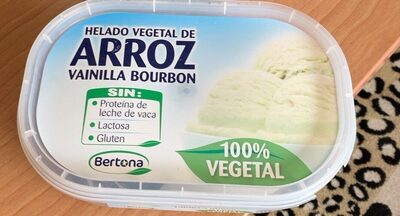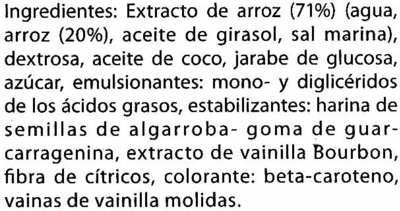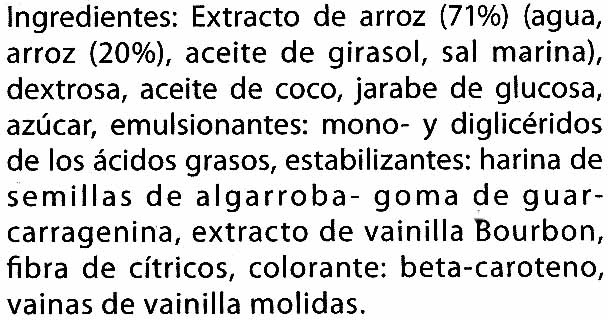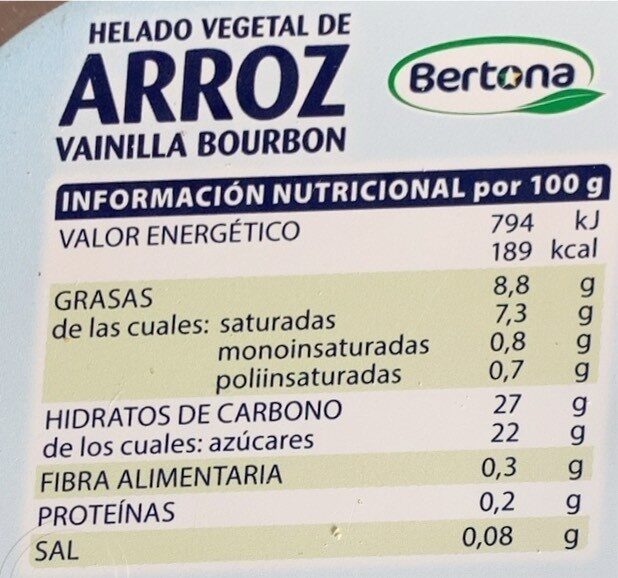Help us make food transparency the norm!
As a non-profit organization, we depend on your donations to continue informing consumers around the world about what they eat.
The food revolution starts with you!
Helado vegetal de arroz vainilla bourbon - Bertona - 500 g, 1000 ml
Helado vegetal de arroz vainilla bourbon - Bertona - 500 g, 1000 ml
This product page is not complete. You can help to complete it by editing it and adding more data from the photos we have, or by taking more photos using the app for Android or iPhone/iPad. Thank you!
×
Barra-kodea: 8006040610034 (EAN / EAN-13)
Izen arrunta: Helado vegetal a base de arroz con vainilla bourbon
Kopurua: 500 g, 1000 ml
Ontziratzea: en:Frozen, es:Tarrina de plástico
Markak: Bertona
Kategoriak: en:Plant-based foods and beverages, en:Dairy substitutes, en:Desserts, en:Frozen foods, en:Frozen desserts, en:Ice creams and sorbets, Izozki, en:Plant-based ice creams, en:Plant-based ice cream tubs
Etiketak, ziurtagiriak, sariak: en:Vegetarian, en:Vegan, en:100% vegetable
Manufacturing or processing places: Italia
Dendak: Mercadona
Saltzen diren herrialdeak: Espainia
Matching with your preferences
Health
Osagaiak
-
30 ingredients
: Extracto de arroz (71%) (agua, arroz (20%), aceite de girasol, sal marina), dextrosa, aceite de coco, jarabe de glucosa, azúcar, emulsionante: mono - y diglicéridos de ácidos grasos (E-471), estabilizante: harina de semillas de algarroba (E-410), goma de guar (E-412), carragenina (E-407), extracto de vainilla Bourbon, fibra de cítricos, colorante: beta-caroteno (E-160a), vainas de vainilla molidas. (Nota del redactor: El producto especifica que es 100% vegetal, por lo que se supone que el aditivo E-471 (mono y diglicéridos de ácidos grasos) es de origen no animal).
Food processing
-
Ultra processed foods
Elements that indicate the product is in the 4 - Ultra prozesatutako elikagaiak eta edariak group:
- Gehigarria: E160a
- Gehigarria: E407
- Gehigarria: E410 - Algarrobo-goma
- Gehigarria: E412
- Gehigarria: E471
- Osagaia: Colour
- Osagaia: Dextrose
- Osagaia: Emulsifier
- Osagaia: Glukosa
- Osagaia: Almibar
Food products are classified into 4 groups according to their degree of processing:
- Prozesatu gabeko edo ahalik eta gutxien prozesatutako elikagaiak
- Sukaldaritzako osagaiak prozesatu
- Prozesatutako jakiak
- Ultra processed foods
The determination of the group is based on the category of the product and on the ingredients it contains.
Gehigarriak
-
E160a
Carotene: The term carotene -also carotin, from the Latin carota, "carrot"- is used for many related unsaturated hydrocarbon substances having the formula C40Hx, which are synthesized by plants but in general cannot be made by animals -with the exception of some aphids and spider mites which acquired the synthesizing genes from fungi-. Carotenes are photosynthetic pigments important for photosynthesis. Carotenes contain no oxygen atoms. They absorb ultraviolet, violet, and blue light and scatter orange or red light, and -in low concentrations- yellow light. Carotenes are responsible for the orange colour of the carrot, for which this class of chemicals is named, and for the colours of many other fruits, vegetables and fungi -for example, sweet potatoes, chanterelle and orange cantaloupe melon-. Carotenes are also responsible for the orange -but not all of the yellow- colours in dry foliage. They also -in lower concentrations- impart the yellow coloration to milk-fat and butter. Omnivorous animal species which are relatively poor converters of coloured dietary carotenoids to colourless retinoids have yellowed-coloured body fat, as a result of the carotenoid retention from the vegetable portion of their diet. The typical yellow-coloured fat of humans and chickens is a result of fat storage of carotenes from their diets. Carotenes contribute to photosynthesis by transmitting the light energy they absorb to chlorophyll. They also protect plant tissues by helping to absorb the energy from singlet oxygen, an excited form of the oxygen molecule O2 which is formed during photosynthesis. β-Carotene is composed of two retinyl groups, and is broken down in the mucosa of the human small intestine by β-carotene 15‚15'-monooxygenase to retinal, a form of vitamin A. β-Carotene can be stored in the liver and body fat and converted to retinal as needed, thus making it a form of vitamin A for humans and some other mammals. The carotenes α-carotene and γ-carotene, due to their single retinyl group -β-ionone ring-, also have some vitamin A activity -though less than β-carotene-, as does the xanthophyll carotenoid β-cryptoxanthin. All other carotenoids, including lycopene, have no beta-ring and thus no vitamin A activity -although they may have antioxidant activity and thus biological activity in other ways-. Animal species differ greatly in their ability to convert retinyl -beta-ionone- containing carotenoids to retinals. Carnivores in general are poor converters of dietary ionone-containing carotenoids. Pure carnivores such as ferrets lack β-carotene 15‚15'-monooxygenase and cannot convert any carotenoids to retinals at all -resulting in carotenes not being a form of vitamin A for this species-; while cats can convert a trace of β-carotene to retinol, although the amount is totally insufficient for meeting their daily retinol needs.Source: Wikipedia (Ingeles)
-
E160ai
Beta-Carotene: β-Carotene is an organic, strongly colored red-orange pigment abundant in plants and fruits. It is a member of the carotenes, which are terpenoids -isoprenoids-, synthesized biochemically from eight isoprene units and thus having 40 carbons. Among the carotenes, β-carotene is distinguished by having beta-rings at both ends of the molecule. β-Carotene is biosynthesized from geranylgeranyl pyrophosphate.β-Carotene is the most common form of carotene in plants. When used as a food coloring, it has the E number E160a. The structure was deduced by Karrer et al. in 1930. In nature, β-carotene is a precursor -inactive form- to vitamin A via the action of beta-carotene 15‚15'-monooxygenase.Isolation of β-carotene from fruits abundant in carotenoids is commonly done using column chromatography. It can also be extracted from the beta-carotene rich algae, Dunaliella salina. The separation of β-carotene from the mixture of other carotenoids is based on the polarity of a compound. β-Carotene is a non-polar compound, so it is separated with a non-polar solvent such as hexane. Being highly conjugated, it is deeply colored, and as a hydrocarbon lacking functional groups, it is very lipophilic.Source: Wikipedia (Ingeles)
-
E407
Carrageenan: Carrageenans or carrageenins - karr-ə-gee-nənz, from Irish carraigín, "little rock"- are a family of linear sulfated polysaccharides that are extracted from red edible seaweeds. They are widely used in the food industry, for their gelling, thickening, and stabilizing properties. Their main application is in dairy and meat products, due to their strong binding to food proteins. There are three main varieties of carrageenan, which differ in their degree of sulfation. Kappa-carrageenan has one sulfate group per disaccharide, iota-carrageenan has two, and lambda-carrageenan has three. Gelatinous extracts of the Chondrus crispus -Irish moss- seaweed have been used as food additives since approximately the fifteenth century. Carrageenan is a vegetarian and vegan alternative to gelatin in some applications or may be used to replace gelatin in confectionery.Source: Wikipedia (Ingeles)
-
E410 - Algarrobo-goma
Locust bean gum: Locust bean gum -LBG, also known as carob gum, carob bean gum, carobin, E410- is a thickening agent and a gelling agent used in food technology.Source: Wikipedia (Ingeles)
-
E412
Guar gum: Guar gum, also called guaran, is a galactomannan polysaccharide extracted from guar beans that has thickening and stabilizing properties useful in the food, feed and industrial applications. The guar seeds are mechanically dehusked, hydrated, milled and screened according to application. It is typically produced as a free-flowing, off-white powder.Source: Wikipedia (Ingeles)
-
E471
Mono- and diglycerides of fatty acids: Mono- and diglycerides of fatty acids -E471- refers to a food additive composed of diglycerides and monoglycerides which is used as an emulsifier. This mixture is also sometimes referred to as partial glycerides.Source: Wikipedia (Ingeles)
Ingredients analysis
-
en:May contain palm oil
Ingredients that may contain palm oil: E471, Karoteno, E471
-
en:Vegan
No non-vegan ingredients
Unrecognized ingredients: es:fibra-de-citricos, es:nota-del-redactor, es:el-producto-especifica-que-es-100-vegetal, es:por-lo-que-se-supone-que-el-aditivo-e471, es:es-de-origen-no-animalSome ingredients could not be recognized.
We need your help!
You can help us recognize more ingredients and better analyze the list of ingredients for this product and others:
- Edit this product page to correct spelling mistakes in the ingredients list, and/or to remove ingredients in other languages and sentences that are not related to the ingredients.
- Add new entries, synonyms or translations to our multilingual lists of ingredients, ingredient processing methods, and labels.
If you would like to help, join the #ingredients channel on our Slack discussion space and/or learn about ingredients analysis on our wiki. Thank you!
-
en:Vegetarian
No non-vegetarian ingredients detected
Unrecognized ingredients: es:fibra-de-citricos, es:nota-del-redactor, es:el-producto-especifica-que-es-100-vegetal, es:por-lo-que-se-supone-que-el-aditivo-e471, es:es-de-origen-no-animalSome ingredients could not be recognized.
We need your help!
You can help us recognize more ingredients and better analyze the list of ingredients for this product and others:
- Edit this product page to correct spelling mistakes in the ingredients list, and/or to remove ingredients in other languages and sentences that are not related to the ingredients.
- Add new entries, synonyms or translations to our multilingual lists of ingredients, ingredient processing methods, and labels.
If you would like to help, join the #ingredients channel on our Slack discussion space and/or learn about ingredients analysis on our wiki. Thank you!
-
Details of the analysis of the ingredients
We need your help!
Some ingredients could not be recognized.
We need your help!
You can help us recognize more ingredients and better analyze the list of ingredients for this product and others:
- Edit this product page to correct spelling mistakes in the ingredients list, and/or to remove ingredients in other languages and sentences that are not related to the ingredients.
- Add new entries, synonyms or translations to our multilingual lists of ingredients, ingredient processing methods, and labels.
If you would like to help, join the #ingredients channel on our Slack discussion space and/or learn about ingredients analysis on our wiki. Thank you!
: Extracto de arroz 71% (agua, arroz 20%, aceite de girasol, sal marina), dextrosa, aceite de coco, jarabe de glucosa, azúcar, emulsionante (mono- y diglicéridos de ácidos grasos (e471)), estabilizante (harina de semillas de algarroba (e410)), goma de guar (e412), carragenina (e407), extracto de vainilla Bourbon, fibra de cítricos, colorante (beta-caroteno (e160a)), vainas de vainilla (Nota del redactor (El producto especifica que es 100% vegetal), por lo que se supone que el aditivo e471 (mono- y diglicéridos de ácidos grasos), es de origen no animal)- Extracto de arroz -> en:rice-extract - vegan: yes - vegetarian: yes - ciqual_proxy_food_code: 9100 - percent_min: 71 - percent: 71 - percent_max: 71
- agua -> en:water - vegan: yes - vegetarian: yes - ciqual_food_code: 18066 - percent_min: 30.92 - percent_max: 51
- arroz -> en:rice - vegan: yes - vegetarian: yes - ciqual_proxy_food_code: 9100 - percent_min: 20 - percent: 20 - percent_max: 20
- aceite de girasol -> en:sunflower-oil - vegan: yes - vegetarian: yes - from_palm_oil: no - ciqual_food_code: 17440 - percent_min: 0 - percent_max: 20
- sal marina -> en:sea-salt - vegan: yes - vegetarian: yes - ciqual_food_code: 11082 - percent_min: 0 - percent_max: 0.08
- dextrosa -> en:dextrose - vegan: yes - vegetarian: yes - ciqual_proxy_food_code: 31016 - percent_min: 2.41666666666667 - percent_max: 29
- aceite de coco -> en:coconut-oil - vegan: yes - vegetarian: yes - from_palm_oil: no - ciqual_food_code: 16040 - percent_min: 0 - percent_max: 26.5833333333333
- jarabe de glucosa -> en:glucose-syrup - vegan: yes - vegetarian: yes - ciqual_proxy_food_code: 31016 - percent_min: 0 - percent_max: 13.2916666666667
- azúcar -> en:sugar - vegan: yes - vegetarian: yes - ciqual_proxy_food_code: 31016 - percent_min: 0 - percent_max: 8.86111111111111
- emulsionante -> en:emulsifier - percent_min: 0 - percent_max: 6.64583333333333
- mono- y diglicéridos de ácidos grasos -> en:e471 - vegan: maybe - vegetarian: maybe - from_palm_oil: maybe - percent_min: 0 - percent_max: 6.64583333333333
- e471 -> en:e471 - vegan: maybe - vegetarian: maybe - from_palm_oil: maybe - percent_min: 0 - percent_max: 6.64583333333333
- mono- y diglicéridos de ácidos grasos -> en:e471 - vegan: maybe - vegetarian: maybe - from_palm_oil: maybe - percent_min: 0 - percent_max: 6.64583333333333
- estabilizante -> en:stabiliser - percent_min: 0 - percent_max: 5.31666666666667
- harina de semillas de algarroba -> en:carob-seed-flour - vegan: yes - vegetarian: yes - ciqual_proxy_food_code: 9410 - percent_min: 0 - percent_max: 5.31666666666667
- e410 -> en:e410 - vegan: yes - vegetarian: yes - percent_min: 0 - percent_max: 5.31666666666667
- harina de semillas de algarroba -> en:carob-seed-flour - vegan: yes - vegetarian: yes - ciqual_proxy_food_code: 9410 - percent_min: 0 - percent_max: 5.31666666666667
- goma de guar -> en:e412 - vegan: yes - vegetarian: yes - percent_min: 0 - percent_max: 4.43055555555555
- e412 -> en:e412 - vegan: yes - vegetarian: yes - percent_min: 0 - percent_max: 4.43055555555555
- carragenina -> en:e407 - vegan: yes - vegetarian: yes - percent_min: 0 - percent_max: 3.79761904761905
- e407 -> en:e407 - vegan: yes - vegetarian: yes - percent_min: 0 - percent_max: 3.79761904761905
- extracto de vainilla Bourbon -> en:bourbon-vanilla-extract - vegan: yes - vegetarian: yes - ciqual_food_code: 11065 - percent_min: 0 - percent_max: 3.32291666666667
- fibra de cítricos -> es:fibra-de-citricos - percent_min: 0 - percent_max: 2.9537037037037
- colorante -> en:colour - percent_min: 0 - percent_max: 2.65833333333333
- beta-caroteno -> en:e160ai - vegan: maybe - vegetarian: maybe - from_palm_oil: maybe - percent_min: 0 - percent_max: 2.65833333333333
- e160a -> en:e160a - vegan: maybe - vegetarian: maybe - from_palm_oil: maybe - percent_min: 0 - percent_max: 2.65833333333333
- beta-caroteno -> en:e160ai - vegan: maybe - vegetarian: maybe - from_palm_oil: maybe - percent_min: 0 - percent_max: 2.65833333333333
- vainas de vainilla -> en:vanilla-pod - vegan: yes - vegetarian: yes - percent_min: 0 - percent_max: 2.41666666666667
- Nota del redactor -> es:nota-del-redactor - percent_min: 0 - percent_max: 2.41666666666667
- El producto especifica que es 100% vegetal -> es:el-producto-especifica-que-es-100-vegetal - percent_min: 0 - percent_max: 2.41666666666667
- por lo que se supone que el aditivo e471 -> es:por-lo-que-se-supone-que-el-aditivo-e471 - percent_min: 0 - percent_max: 1.20833333333333
- mono- y diglicéridos de ácidos grasos -> en:e471 - vegan: maybe - vegetarian: maybe - from_palm_oil: maybe - percent_min: 0 - percent_max: 1.20833333333333
- es de origen no animal -> es:es-de-origen-no-animal - percent_min: 0 - percent_max: 0.805555555555555
- Nota del redactor -> es:nota-del-redactor - percent_min: 0 - percent_max: 2.41666666666667
Elikadura
-
Poor nutritional quality
⚠ ️Warning: the amount of fruits, vegetables and nuts is not specified on the label, it was estimated from the list of ingredients: 0This product is not considered a beverage for the calculation of the Nutri-Score.
Positive points: 0
- Proteinak: 0 / 5 (balioa: 0.2, rounded value: 0.2)
- Fiber: 0 / 5 (balioa: 0.3, rounded value: 0.3)
- Fruits, vegetables, nuts, and colza/walnut/olive oils: 0 / 5 (balioa: 0, rounded value: 0)
Negative points: 13
- Energia: 2 / 10 (balioa: 794, rounded value: 794)
- Azukreak: 4 / 10 (balioa: 22, rounded value: 22)
- Gantz saturatua: 7 / 10 (balioa: 7.3, rounded value: 7.3)
- Sodioa: 0 / 10 (balioa: 32, rounded value: 32)
The points for proteins are not counted because the negative points are greater or equal to 11.
Nutritional score: (13 - 0)
Nutri-Score:
-
Nutrient levels
-
Koipe in moderate quantity (8.8%)
What you need to know- A high consumption of fat, especially saturated fats, can raise cholesterol, which increases the risk of heart diseases.
Recommendation: Limit the consumption of fat and saturated fat- Choose products with lower fat and saturated fat content.
-
Gantz-azido ase in high quantity (7.3%)
What you need to know- A high consumption of fat, especially saturated fats, can raise cholesterol, which increases the risk of heart diseases.
Recommendation: Limit the consumption of fat and saturated fat- Choose products with lower fat and saturated fat content.
-
Azukre in high quantity (22%)
What you need to know- A high consumption of sugar can cause weight gain and tooth decay. It also augments the risk of type 2 diabetes and cardio-vascular diseases.
Recommendation: Limit the consumption of sugar and sugary drinks- Sugary drinks (such as sodas, fruit beverages, and fruit juices and nectars) should be limited as much as possible (no more than 1 glass a day).
- Choose products with lower sugar content and reduce the consumption of products with added sugars.
-
Gatz arrunt in low quantity (0.08%)
What you need to know- A high consumption of salt (or sodium) can cause raised blood pressure, which can increase the risk of heart disease and stroke.
- Many people who have high blood pressure do not know it, as there are often no symptoms.
- Most people consume too much salt (on average 9 to 12 grams per day), around twice the recommended maximum level of intake.
Recommendation: Limit the consumption of salt and salted food- Reduce the quantity of salt used when cooking, and don't salt again at the table.
- Limit the consumption of salty snacks and choose products with lower salt content.
-
-
Nutrition facts
Nutrition facts As sold
for 100 g / 100 mlCompared to: en:Plant-based ice cream tubs Energia 794 kj
(189 kcal)+% 5 Koipe 8,8 g +% 20 Gantz-azido ase 7,3 g +% 64 Gantz-azido monoasegabe 0,8 g Polyunsaturated fat 0,7 g Carbohydrates 27 g +% 4 Azukre 22 g -% 2 Fiber 0,3 g Proteina 0,2 g -% 85 Gatz arrunt 0,08 g -% 30 Fruits‚ vegetables‚ nuts and rapeseed‚ walnut and olive oils (estimate from ingredients list analysis) 0 %
Ingurumena
-
Eco-Score B - Ingurumen-eragin txikia
The Eco-Score is an experimental score that summarizes the environmental impacts of food products.→ The Eco-Score was initially developped for France and it is being extended to other European countries. The Eco-Score formula is subject to change as it is regularly improved to make it more precise and better suited to each country.Life cycle analysis
-
Average impact of products of the same category: A (Score: 87/100)
Kategoria: Ice cream, cone (normal size)
Kategoria: Ice cream, cone (normal size)
- PEF environmental score: 0.22 (the lower the score, the lower the impact)
- including impact on climate change: 1.75 kg CO2 eq/kg of product
Stage Impact Agriculture
56.9 %Processing
18.1 %Ontziratzea
6.7 %Transportation
6.9 %Distribution
7.2 %Consumption
4.2 %
Bonuses and maluses
-
Missing origins of ingredients information
Malus: -5
⚠ ️ The origins of the ingredients of this product are not indicated.
If they are indicated on the packaging, you can modify the product sheet and add them.
If you are the manufacturer of this product, you can send us the information with our free platform for producers.
-
Packaging with a medium impact
Malus: -10
Shape Material Recycling Impact Terrine pot Plastic Altua
Eco-Score for this product
-
Impact for this product: B (Score: 72/100)
Produktua: Helado vegetal de arroz vainilla bourbon - Bertona - 500 g, 1000 ml
Life cycle analysis score: 87
Sum of bonuses and maluses: -15
Final score: 72/100
-
Carbon footprint
-
Equal to driving 0.9 km in a petrol car
175 g CO² per 100g of product
The carbon emission figure comes from ADEME's Agribalyse database, for the category: Ice cream, cone (normal size) (Source: ADEME Agribalyse Database)
Stage Impact Agriculture
61.0 %Processing
12.3 %Ontziratzea
10.3 %Transportation
11.3 %Distribution
3.7 %Consumption
1.4 %
Ontziratzea
-
Packaging with a medium impact
-
Packaging parts
Terrine pot (Plastic)
-
Bilgarriaren materialak
Material % Bilgarriaren pisua Bilgarriaren pisua produktuaren 100g-ko Plastic
-
Transportation
-
Origins of ingredients
Missing origins of ingredients information
⚠ ️ The origins of the ingredients of this product are not indicated.
If they are indicated on the packaging, you can modify the product sheet and add them.
If you are the manufacturer of this product, you can send us the information with our free platform for producers.Add the origins of ingredients for this product Add the origins of ingredients for this product
Report a problem
-
Incomplete or incorrect information?
Category, labels, ingredients, allergens, nutritional information, photos etc.
If the information does not match the information on the packaging, please complete or correct it. Open Food Facts is a collaborative database, and every contribution is useful for all.
Datuen iturria
Product added on by jerusa
Last edit of product page on by gmlaa.
Produktuaren orria -gatik editatua javichu, kiliweb, musarana, packbot, roboto-app, yuka.sY2b0xO6T85zoF3NwEKvlkMacNncozSUDkPnwGrQyPCxBZPxX_Rj_JXBHao.











